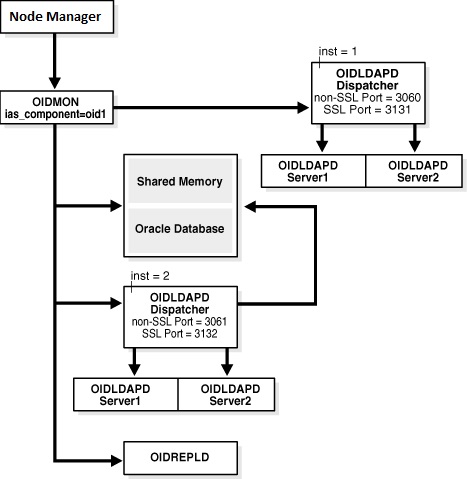A.2 Managing Oracle Internet Directory Instances by Using OIDCTL
This appendix includes the following sections:
-
Creating and Starting an Oracle Internet Directory Server Instance by Using OIDCTL
-
About Stopping an Oracle Internet Directory Server Instance by Using OIDCTL
-
About Starting an Oracle Internet Directory Server Instance by Using OIDCTL
-
Deleting an Oracle Internet Directory Server Instance by Using OIDCTL
A.2.1 About Managing Oracle Internet Directory by Using OIDCTL
Some customers need to run Oracle Internet Directory in standalone mode, without a WebLogic domain or Oracle Enterprise Manager
Fusion Middleware Control. If you are running Oracle Internet Directory in standalone mode, you can use oidctl add to create additional instances of Oracle Internet Directory within an existing Oracle Internet Directory component. If you create an Oracle Internet Directory instance by using oidctl, your new instance is not visible to a WebLogic server and you are not able to manage the instance by using Oracle Enterprise Manager
Fusion Middleware Control.
The inst argument to oidctl is an integer. That is, the first server instance is 1 (inst=1) and the second is 2, and so forth.
Figure A-1 shows a single Oracle Internet Directory component with two Oracle Internet Directory instances. Each instance has its own dispatcher with a non-SSL and an SSL port. Both dispatchers are controlled by the same OIDMON.
Figure A-1 A Component with Two Instances

Creating a new instance in this manner also creates a new instance-specific configuration entry with the new instance number appended to the component name. For example, if the first instance-specific configuration entry was:
cn=oid1,cn=osdldapd,cn=subconfigsubentry
then the second instance-specific configuration entry is:
cn=oid1_2,cn=osdldapd,cn=subconfigsubentry
You can manage the two instances independently by using LDAP tools or Oracle Directory Services Manager. The new instance cannot be registered with a WebLogic domain, so you cannot use Oracle Enterprise Manager Fusion Middleware Control or WLST to manage it.
Creating an Oracle Internet Directory instance in this manner does not generate any new pathnames in the file system. Instances that are part of the same Oracle Internet Directory component read from the same configuration files and write log files to the same log directory.
For backward compatibility, Oracle Internet Directory 11g Release 1 (11.1.1.0.0) also allows you to create an instance with default attribute values by using oidctl add.
A.2.2 Creating and Starting an Oracle Internet Directory Server Instance by Using OIDCTL
You can create another Oracle Internet Directory server instance within an existing component and start the server by using oidctl add. This command starts the server as well.
Note:
-
You must set the environment variables
DOMAIN_HOMEandORACLE_HOMEbefore you run theoidctlcommand. -
If you do not specify the Oracle Internet Directory instance name and component name to
oidctl, the command uses the default valueinst1oroid1respectively. If you must specify different values, you can either set the environment variablesINSTANCE_NAMEandCOMPONENT_NAME, or pass the instance name and component name in the command line asname=instanceName,componentname=componentName, respectively. -
Best practice is to create new Oracle Internet Directory instances by creating new Oracle Internet Directory components, as described in Managing Oracle Internet Directory Instances. You should only use
oidctlto create an instance if you plan to run Oracle Internet Directory in standalone mode and never use Oracle Enterprise Manager Fusion Middleware Control.
To create and start the server by using oidctl add, type:
oidctl connect=connect_string server=oidldapd inst=new_instance_number \ name=instanceName componentname=componentName \ flags="port=non_ssl_port sport=ssl_port" add
oidctl add creates the new configuration entry:
cn=componentName_new_instance_number,cn=osdldapd,cn=subconfigsubentry
Typically, the inst value of the original instance is 1, the second instance you create is 2, and so forth. For example:
oidctl connect=oiddb server=oidldapd inst=2 flags="port=3322 sport=3323" add
A.2.3 About Stopping an Oracle Internet Directory Server Instance by Using OIDCTL
If you have an Oracle Internet Directory server instance within a component that was created by using oidctl, and the instance has been started, you can stop it by executing the following command.
To stop the server instance, execute the following command:
oidctl connect=connect_string server=oidldapd inst=new_instance_number stop
For example:
oidctl connect=oiddb server=oidldapd inst=2 stop
A.2.4 About Starting an Oracle Internet Directory Server Instance by Using OIDCTL
If you have an Oracle Internet Directory server instance within a component that was created by using oidctl, and the instance has been stopped, you can start it by executing the following command.
To start the server instance, execute the following command:
oidctl connect=connect_string server=oidldapd inst=new_instance_number start
For example:
oidctl connect=oiddb server=oidldapd inst=2 start
The server is started with the port and sport flags that were specified when the instance was created.
A.2.5 Viewing Status Information by Using OIDCTL
You can use oidctl to view status.
Type:
oidctl connect=connect_string status
The command oidctl status displays the status of all the Oracle Internet Directory instances that are running on the host, even though they might be on different Oracle instances.
A.2.6 Deleting an Oracle Internet Directory Server Instance by Using OIDCTL
You can stop and permanently delete one Oracle Internet Directory server instance within a component by executing the command specified below.
To stop and permanently delete one Oracle Internet Directory server instance within a component, type
oidctl connect=connect_string server=oidldapd inst=new_instance_number \ name=instanceName componentname=componentName delete
Only the connect, server, and inst arguments are required. oidctl delete deletes the configuration entry:
cn=componentName_new_instance_number,cn=osdldapd,cn=subconfigsubentry
Typically, the inst value of the original instance is 1, the second instance you create is 2, and so forth. For example:
oidctl connect=oiddb server=oidldapd inst=2 delete